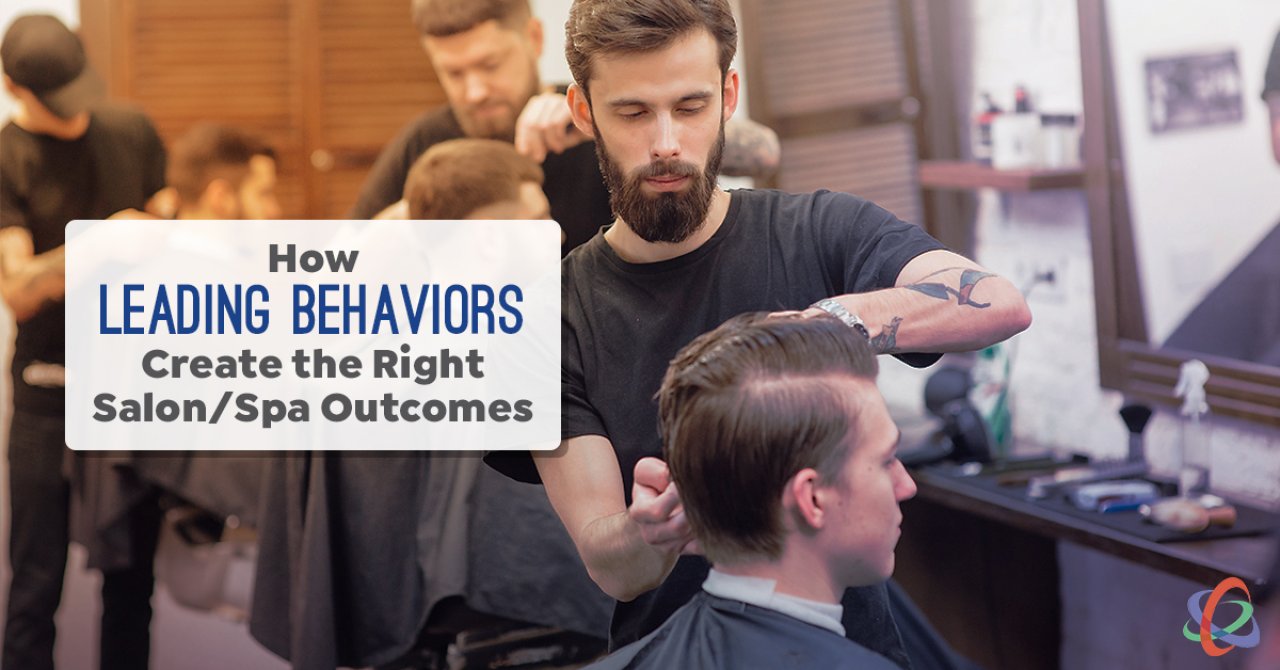How Leading Behaviors Create the Right Salon/Spa Outcomes

Sometimes salon and spa owners just can’t stop themselves.
They react to the performance numbers they don’t like seeing, morph into “task master” mode, and proceed to tell everyone, “You need to get these numbers up.”
The importance of getting “the numbers” up is a no brainer. But “the numbers” are an outcome. And achieving the right outcomes means getting the behaviors right.
- Leading through Behaviors vs Managing the Outcomes/Results.
On the extreme …
Rent and payroll taxes are due, productivity and pre-book rates are in the danger zone. Making goal looks more and more like a pipe dream. The company is telling you, “Hey fearless leader, our cash reserve is depleted, and you need to fix this now.”
The leader misinterprets how the salon/spa got into this condition and becomes reactive instead of proactive.
The leader begins speaking in numbers and not about the behaviors. Employees react by thinking that the company has become all “corporate” and all the leader cares about are the “numbers.”
In the normal day-to-day …
All seems normal, but that's the problem. Performance-wise, the salon/spa is flat. The team is far from engaged. Behind the scenes resentment and disenchantment sets in. Everyone dreads the “all about the numbers” daily huddle. It doesn’t seem to bother anyone (except the owner) that, “yet again, we did not hit goal.”
Communication is all about the numbers: “Yesterday we missed our service goal,” or, “If we don’t start selling more, there will be no team bonus.” (Meanwhile, that little voice in the leader’s head is pointing the finger saying, "It’s all your fault!”). “Sell More. Sell More Blah Blah,” is all the team hears.
These two scenarios describe what happens when the team is managed by the numbers. Numbers become a weapon.
It seems obvious, we don’t have “XX,” we need to get “XX” — and we need to get it now.
Data, metrics and numbers can all be boiled down to this; they are simply “outcomes of behaviors.”
If numbers are a result of behavior, what if your leadership and coaching focused on those behaviors (and skills) capable of achieving essential target outcomes? FACT: The simplest behaviors often have the greatest impact on the outcomes.
Remember that test you took in school that you aced? You took stellar notes and studied hard. You were prepared to take the test and you knew the information. The teacher handed out the test. You methodically worked through every question to answer them correctly. You turned in the test feeling proud of how you performed. The next day, you were rewarded with a nearly perfect grade.
The grade was the outcome you prepared for. The grade was a result of all the behaviors that lead up to the moment you completed the test.
Now, consider how you lead your team. Are you leading them to achieve the desired outcomes by mastering the behaviors that achieve them? Or, are you strictly looking at the numbers? FACT: When performance needs to improve, coach your team on the behaviors that produce the desired outcomes. Help them master the behaviors and the rest will take care of itself.
- What does business contraction look like? Contraction could be a good thing, like a reduction in spending. But a contraction in the number of first-time clients and overall client count is like a warning shot fired across your bow.
The scenario …
Existing client retention is 85%. By all outward appearances, you and your team think they’re knocking it out of the park.
However, your first-time client retention is 43%. That’s not too bad. But is there a warning shot here you’re missing? If your current monthly client count is 500, and you’re retaining 85% of them, that’s a reduction of 75 clients per month.
The flip side of the retention scenario …
Your new client count is 125 and only 43% of are retained, that’s roughly 54 new clients added to the client base.
Lastly, your average productivity rate for the year is 65%.
The warning shot: Your salon/spa is not retaining first-time clients at a high enough rate to offset attrition from your existing client base. That’s the reason your productivity rate is declining. Something needs to change. That “something” is the behaviors that improve first-time and existing client retention — and productivity rate.
If your response is to hammer away that “the numbers” need to improve, and improve fast, you’ll be hammering away at the outcome — not developing the behaviors that can turn a discouraging situation around.
The behaviors that need leadership focus and coaching are about improving customer service, professional consultations and guidance, pre-booking, retail product recommendations, frequency of visit, just to name a few. The numbers won’t improve until the behaviors improve.
- What your “Average Service Revenue Per Hour” is really telling you.
Struggling to hit goal, but confused because your …
- Productivity is at 86%.
- Goal was based on Services that were Priced for Desired Profit.
- Monthly results of your Average Service Revenue Per Hour is far from consistent.
Things to consider …
- Are you projecting service sales based on Average Service Revenue Per Hour with profit margin factored in (Cost Per Hour + Profit Margin = Service Price)? Break the service price into 15-minute increments to easily price services that take less or more than one hour.
- Are all service providers held to the same Time-Standards? If a service price is based on 45-minutes and a service provider routinely takes one hour, you’re losing money on that service if the cost for the additional 15 minutes isn’t added.
- Be sure that all services are correctly timed and priced in your POS, including add-ons/up-sells that are performed during a larger service appointment.
- Do you have tiered, or level, pricing? How many tiers/levels? Is each tier/level service price set to create profit?
It’s important to calculate if your salon/spa service pricing is set correctly while also factoring in your productivity rate. FACT: The lower your productivity rate, the higher your Cost Per Hour. The higher your productivity rate, the higher your profit margin.
While working with Strategies Coaching clients, it’s not unusual to see a company’s Average Service Revenue Per Hour go up and down like a roller coaster. It’s up, it’s down, it’s flat, it’s back up. Why is this? If the monthly goal is calculated on Average Service Revenue Per Hour x projected hours to be sold, why would it fluctuate? How does this effect the goal and the outcomes?
A. Service Time Standards …
- If a client has an appointment, but the service provider is not trained to work within time standards for that service — and takes 15 or 30 minutes over the time standard — the salon/spa is going to lose money on every service performed by that person.
- If your salon/spa has different team members that require different scheduling times for the same services, your internal training program is not working or non-existent. FACT: As a service business, your salon/spa sells time. Time standards are not optional.
- In a toxic culture, a service provider can instruct, or even bully, front desk staff to schedule more time for services, or add time between services with no oversight. Too often, a salon/spa can look really busy when it’s actually operating with gross inefficiency.
B. Pricing Appropriately …
- A particular client requires extra time to complete a service and charged based on the standard time. This is a common occurrence that often results in coming up short on goal. The service provider is either not paying attention or is uncomfortable discussing price with clients.
- More nefarious is the person checking the client out might charge appropriately for the extra time, but only ring up the standard time price and keep the difference. This is called “stealing.” (Seen it, experienced it.)
The above scenarios all cause the total service sales to come in short of goal as well as the Total Number of Hours Sold to be calculated incorrectly. This all results in a lower Average Service Revenue Per Hour, misleading productivity rates, and revenue projections that are far from accurate.
Solutions …
- All employees must know and understand the why and how a salon/spa makes money and need to be included in solving performance and behavior challenges.
- Education and Team Training around performing services, such as implementing a comprehensive Internal Training Program.
- Celebrate Wins.
Here’s my challenge to you: The next time you think of saying, “You’ve got to get your numbers up,” STOP. You can’t create the desired outcomes by focusing on the outcome’s number. That’s like trying to lose weight while standing on a scale eating Twinkies and drinking beer. It’s the behavior that needs training, coaching and persistent support.


Comments
No comments found. Start the conversation!
Leave a Comment